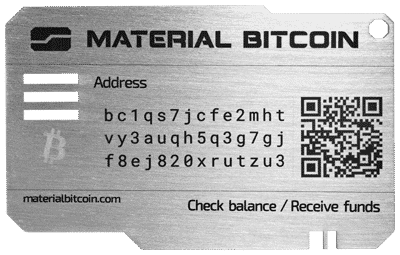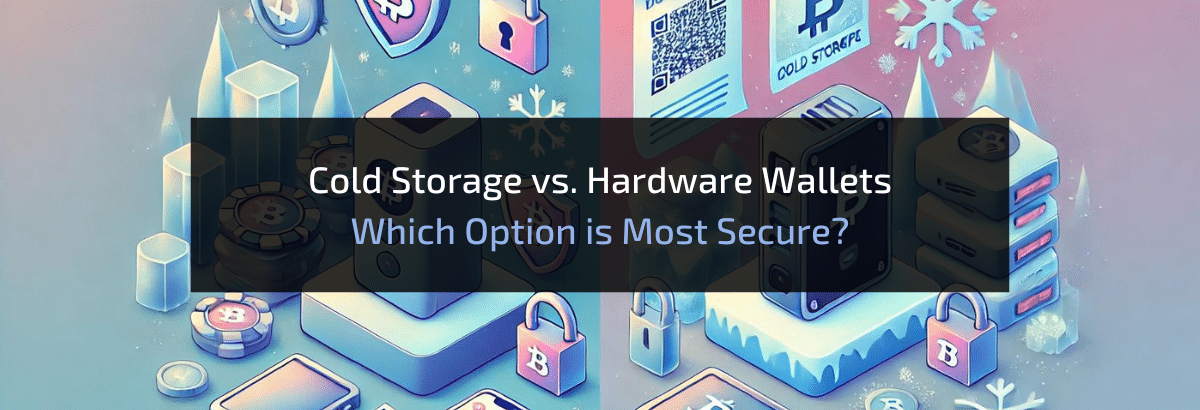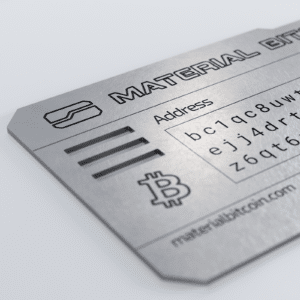Safeguarding your crypto in secure storage is absolutely crucial, especially as the value of Bitcoin and Ethereum continue to rise.
But, as the value grows, so does the desire for hackers to obtain your assets. Knowing exactly where and how to store your crypto can make all the difference between peace of mind and constant stress and worry.
Two of the most popular methods for securing your crypto are Cold Storage and Hardware Wallets. Each offers a different approach to keeping your crypto safe, with advantages and drawbacks.
In this post, we’ll break down Cold Storage vs. Hardware Wallets, exploring their differences, similarities, pros and cons, to help you decide which is the safest way to store your crypto!
What is Cold Storage?
Cold storage is defined as an offline method of storing cryptocurrencies. This disconnection from the internet is what makes cold storage one of the safest ways to protect your crypto from online threats like hacking, phishing, and other cyberattacks.
Unlike hot wallets, which are constantly connected online, cold storage guarantees that your private keys are stored in a way that’s almost impossible for even the most advanced hackers.
Types of Cold Storage
Paper Wallets

A paper wallet is one of the simplest forms of cold storage. Your private and public keys are generated and printed on a piece of paper. The idea is that since this piece of paper is never connected to the internet, it’s safe from online threats.
If you want to buy or sell crypto, you would need to manually enter the keys or scan a QR code from the paper wallet to do so. But, the downside is that paper wallets are easily damaged through normal wear and tear and can be easily misplaced or lost.
Metal Wallets

Metal crypto wallets are very similar to paper wallets, but just an upgraded version of them. They have the same purpose: storing your private keys offline. But, they have advanced durability.
Typically made from stainless steel or titanium, metal wallets are designed to withstand extreme conditions, like fire, water, or physical impact. For these reasons, they are the best option for long-term storage.
Material Bitcoin
When it comes to cold storage, Material Bitcoin is a great solution. What makes Material Bitcoin so unique from other cold wallets is that it takes cold storage a step further by combining security and durability with user-friendliness.
Material Bitcoin has tamper-proof packaging, so you can be sure that your wallet hasn’t been accessed or compromised during its creation or delivery.
What is a Hardware Wallet?
A hardware wallet is a physical device specifically designed to store your cryptocurrency’s private keys. There are two versions of hardware wallets:
1️⃣Electronic hardware wallets
2️⃣Non-electronic hardware wallets (which are considered to be cold wallets)
Electronic Hardware Wallets
These are the most common types of hardware wallets. Popular examples include the Ledger Nano X, Ellipal Titan and the Trezor Model T. These devices are small, portable, and connect to your computer or smartphone via USB or Bluetooth.
They support multiple cryptocurrencies and usually have easy-to-use interfaces for managing your assets.
Electronic hardware wallets are ideal for those who need to access their funds regularly but want to keep them more secure than leaving them on an exchange. Prices typically range from $60 to $200, depending on the features and the brand.
Non-Electronic Hardware Wallets
Like steel wallets, these are not digital devices but rather physical objects made from durable materials. They’re designed to hold your private keys or recovery phrases in a 100% offline manner. While they don’t have the same functionality as electronic wallets, they are the best way to store your keys securely. Some popular examples include Material Bitcoin and Tangem.
Cold Storage vs. Hardware Wallet: What’s the Difference Really?
Accessibility
Cold Storage: Accessing your funds with cold storage often requires more steps, such as retrieving your private keys from a paper or metal wallet. This makes it less convenient but offers higher security for long-term storage. Although many versions offer QR Codes and TAP technology to aid in accessibility.
Hardware Wallets: These devices are easier and quicker to access, making them more convenient for regular use. You can connect them to your computer or phone and manage your funds with just a few clicks.
Security
Cold Storage: Since cold storage is completely offline, it’s immune to online hacks.
Hardware Wallets: While still very secure, hardware wallets are electronic devices, which means they could be targeted if not properly managed. The software on the device and/or the programs used to manage your crypto can be compromised with malware or hacked.
Cost
Cold Storage: Generally speaking, cold storage is more affordable, due to its lack of screens, lights, tech, etc.
Hardware Wallets: These devices have a higher upfront cost because of the technology involved. Prices range from $60 to over $200.
Best For
Cold Storage: Ideal for long-term holding. It’s perfect for securing large amounts of cryptocurrency that you plan to keep for a long time.
Hardware Wallets: Best suited for those who need regular access to their crypto.
| Cold Storage | Hardware Wallet | |
|---|---|---|
| ✅Pros |
|
|
| ❌Cons |
|
|
☝️Pro Tip: Storing your cold wallet in a physical safe or even a security box at a bank will give you added protection.
Which is Better for You? Choosing the Right Solution
When deciding between cold storage vs. hardware wallet, consider your personal needs, circumstances and investing strategy.
Ask Yourself These 5 Questions First:
1. What are Your Needs?
- Are you planning to hold onto your assets for the long term, or do you need regular access to your funds?
2. How Much Security Do You Require?
- How much security do you need based on the amount you’re storing and your risk tolerance? If maximum security is your top priority, cold storage is the way to go.
3. What’s Your Budget?
- Can you afford the upfront cost of a hardware wallet, or are you looking for a more budget-friendly solution like cold storage?
4. How User-Friendly Do You Need It to Be?
- Are you a beginner or someone who prefers a straightforward, easy-to-use solution? If you’re new to cryptocurrency or just want a hassle-free experience, cold storage like Material Bitcoin is an easier option.
5. How Comfortable Are You with Technology?
- Do you feel confident navigating more complex devices, or would you prefer something simple? If you’re not tech-savvy, nor want the responsibility of charging your device or updating its software, then a hardware wallet is not a good choice.
Our Top Picks for Best Cold Storage and Hardware Wallets
| Wallet | Price |
|---|---|
| Hardware Wallet: NGRAVE ZERO | $398 |
| Hardware Wallet: Ellipal Titan | $169 |
| Cold Storage: Material Bitcoin | $94.99 |
| Cold Storage: Tangem Wallet | $54.99 – $69.90 |
For further details and more storage options, read our guide about the Best Hardware Wallets.
Doing What’s Best For You
Choosing the right storage solution for your cryptocurrency is crucial for keeping your assets safe and accessible.
Whether you pick cold storage or a hardware wallet depends on your specific needs, including how often you need access to your funds, your security requirements, and your comfort with technology.
Ultimately, the best choice is the one that aligns with your investment strategy and personal preferences. Happy Investing!










0 Comments